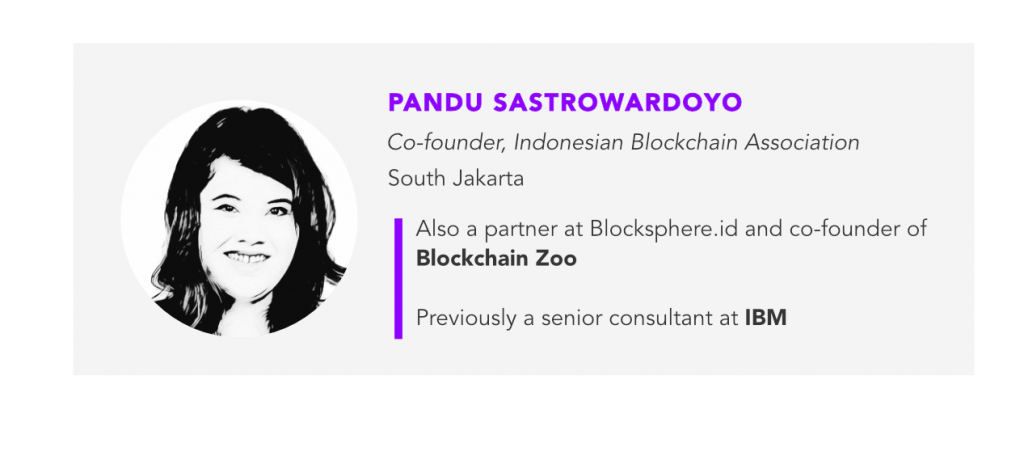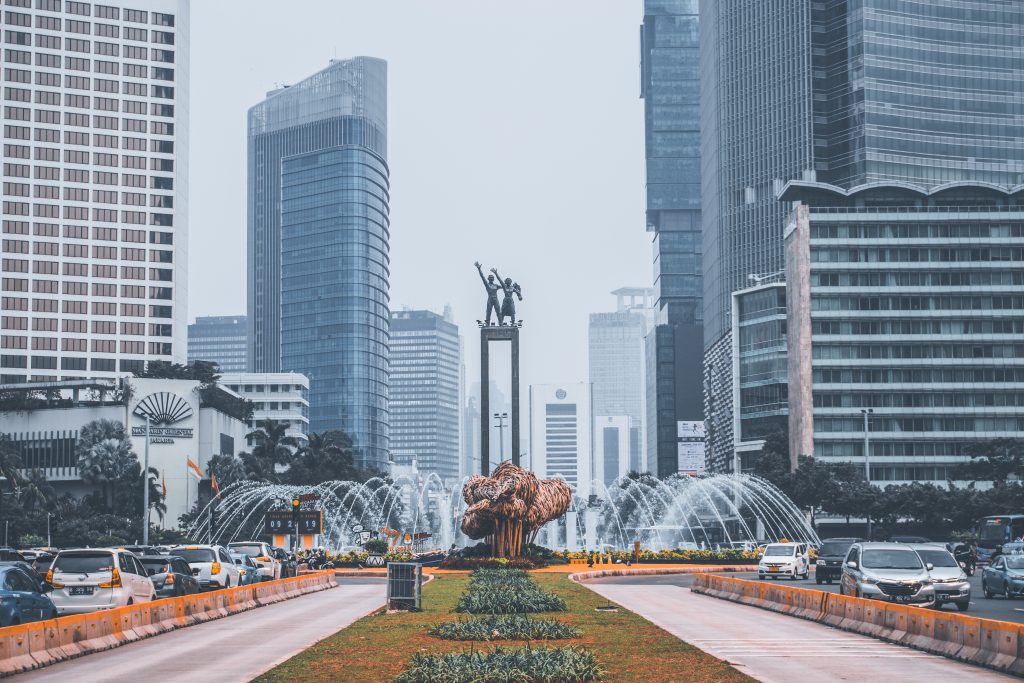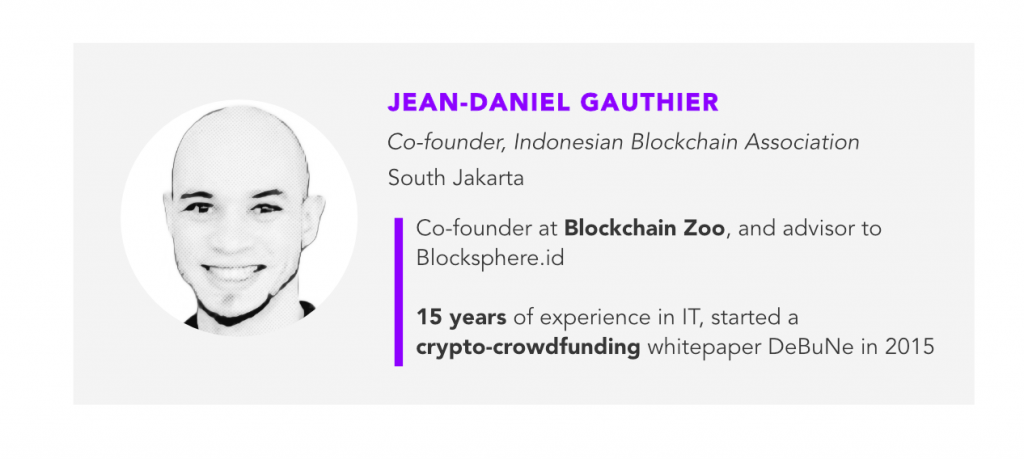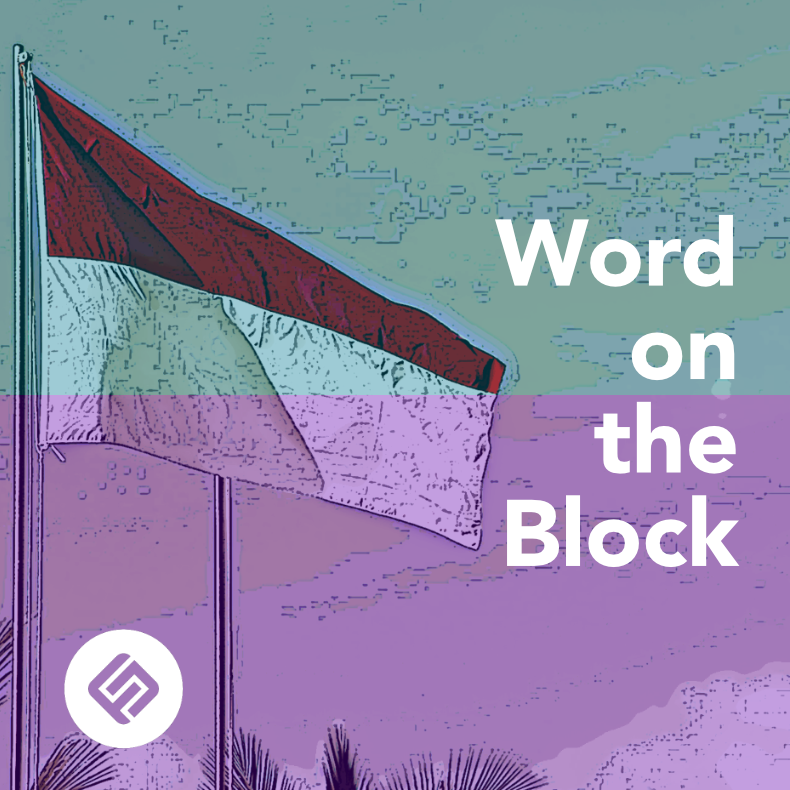As China’s digital currency is said to be “progressing,” Indonesia might also release its own white paper in 2020, according to Indonesian Blockchain Association cofounder Pandu Sastrowardoyo.
“The development of fiat digital currencies is progressing smoothly,” reads a report by the People’s Bank of China at its latest annual work conference. China’s central bank has been working on creating a digitized domestic currency since 2014, but has not clarified when it would be launched. Last year, a report by influential Chinese financial news publisher Caijing said that a pilot of the digital currency could be launched in Shenzhen by the end of 2019.
Indonesia is also considering using its own Central Bank Digital Currency (CBDC) to share data between its provincial banks. A national digital currency may help central banks combat money laundering and curb illicit activities.

Key Highlights
- “Actually, the Indonesian government was really focused on trying to get blockchain into the systems and to help integrate data and help multiple agencies collaborate. That is why we cofounded the Indonesian Blockchain Association, to help the government understand and to apply these technologies in real-world conditions.”
- “It’s all very interesting the way Indonesia is actually leapfrogging, not going through the formal education route, but going straight to practical [blockchain] knowledge.”
- “Indonesia’s 33 provinces each have one bank, and to share data between those banks and especially to combat anti-fraud, they are doing research on using blockchain [for that purpose].”
- “We were involved in the research that is going on related to central bank digital currencies, CBDCs, and the Indonesian Central Bank, Bank Indonesia has done several workshops… with local fintech companies. Hopefully in 2020 they’ll release a white paper that is related to the usage of blockchain in central bank digital currencies.”
- “Indonesia’s digital payments space is actually very fragmented right now. There have also been cases of fraud because of the fragmentation. The current possible solutions include integrating QR payment solutions on top of one platform that can be used by multiple QR payment providers and that can be done on the blockchain. That’s something interesting for 2020.”
- “Now I think in 2020, what will appear will be more platforms, more blockchain-as-a-service platforms from corporations and more platforms for intergovernmental collaborations created within Indonesia for Indonesian agencies and a lot of solutions that help multiple companies to work together.”
See related article: Why is China’s Central Bank Launching a Digital Currency? Chicago Booth Economist Explains the Impact
“We were involved in the research that is going on related to CBDCs, and the Indonesian Central Bank, Bank Indonesia has done several workshops… with local fintech companies,” said Sastrowardoyo. “Hopefully in 2020 they’ll release a white paper that is related to the usage of blockchain in central bank digital currencies,” she said.

The Indonesian Blockchain Association seeks to promote the adoption of blockchain in Indonesia primarily in terms of education, regulations and commercialization. The association works with local financial regulators, fintech association and law enforcement.
Sastrowardoyo said the currency’s proof of concept would not be retail-focused, but a wholesale-focused digital currency used for interbank settlements. “Probably inter-country settlements as well, a lot like what Singapore did with their project Ubin, [Indonesia is] actively looking towards that,” she said.
Singapore’s project Ubin uses blockchain and distributed ledger technology for the clearing and settlement of payments and securities. China’s digital currency has not been announced as a cryptocurrency.
“The currency is not for speculation,” said Mu Changchun, head of the People’s Bank of China’s digital currency research institute, in an interview with Shanghai Securities News in December 2019. “It is different to bitcoin or stable tokens, which can be used for speculation or require the support of a basket of currencies,” he said.
While Indonesia’s central bank prohibits the use of cryptocurrencies such as Ethereum or Bitcoin for payments, it revealed plans to explore its own digital currency in 2018.
“The physical banknotes we currently use may be converted into digital money. However, no country has released such money yet,” said Bank of Indonesia executive director for payment systems Susiato Dewi in kompas.com. Dewi added that the CBDC would be based on the current currency value and inflation rates.
Listen to the Podcast
Full Transcript
Angie Lau: Welcome to Word on the Block, the series that takes a deeper dive into the topics we cover right here on Forkast.News. I’m Editor-in-Chief Angie Lau. As we kick off 2020, we take a look at the blockchain space and the trends that are emerging around the world.
On this episode, we’re focusing on Southeast Asia, and we take a closer look at Indonesia, this nation that is an archipelago of 17,000 islands which blockchain has the potential to unify. We’re deep diving today with Pandu Sastrowardoyo and Jean-Daniel Gauthier, cofounders of Indonesian Blockchain Association, and both are senior consulting partners at Blocksphere.id, a firm they both founded. So welcome Pandu and Jean-Daniel dialing in from South Jakarta, Indonesia. How are you both?
Pandu Sastrowardoyo: We’re doing well.
Jean-Daniel Gauthier: Fantastic.
Lau: Excellent. How is blockchain doing in Indonesia?

Sastrowardoyo: A lot of exciting stuff is actually happening here.
Gauthier: There is, nothing else to say.
Lau: Well, tell us about how this technology has really emerged for Indonesia, where it started. As we head into 2020, what are the things that people are really paying attention to in Indonesia?
Sastrowardoyo: So I’m just going to start with the background and Daniel will probably be able to tell us about the trends of 2020. The background of how Indonesia became so interested in blockchain technology is actually, as you mentioned, we have 17,000 islands, which is a lot of agendas and a lot of decentralization.
I always call my country, Indonesia, a decentralized country simply because it’s followed a democratic philosophy of really strong regional autonomy. We have 33 provinces and there is a distinct focus on provincial empowerment. This kind of administrative decentralization has actually created a lot of problems in the past. In the 75 years that Indonesia has existed, there are tons of different standards, SOPs [standard operating procedures] and IT systems. Different provinces might have different SOPs, different standards.
It’s really hard, especially in today’s era of big data, to actually get a unified view of Indonesia itself. Building a unified strategy for it is also very difficult. The basis of this is the amount of the administrative decentralization, as I mentioned, [causing] a lot of differing agendas, a lot of competing agendas. So it’s very difficult for an Indonesian company or a government agency to get one source of data.
A very good example is every Indonesian has multiple identity cards, whether it’s the government social insurance card, a voting card — we might have multiple identities simply because there are multiple provinces and multiple agencies that sometimes don’t talk to each other. That [led] research into blockchain to take hold really early when everyone else was focused on cryptocurrencies.
Actually, the Indonesian government was really focused on trying to get blockchain into the systems and to help integrate data and help multiple agencies collaborate. So these conditions are also why we cofounded the Indonesian Blockchain Association, to help the government understand this and to apply these technologies in real-world conditions.
Lau: So Jean-Daniel, in 2020, what can we expect?
Gauthier: We can expect a lot of good things, and to understand a little bit more where it comes from. We need to know a little bit more about the past. In 2017-18 we saw a rapid gain of interest from traders and crypto enthusiasts, the “nerd money,” but 2019 has seen measurable growth in the ranks of its blockchain-capable developers. There’s been dozens of seminars, workshops, dedicated new websites have been launched.
Thanks to the combined efforts of many, many actors in the industry, we can see that the interest is now shifting from all the initial offerings … towards actual application of the technologies. This is also due to the emergence of more mature technical frameworks. For instance, the Hyperledger suite and tools like Ganache and Truffle for Ethereum. So the question for these developers is where do we start? How can we how can we begin learning?
Lau: I want to understand that a little bit better. You say measurable growth amongst developers. Where are people learning about blockchain? Are they getting educated in universities? Where does this start?
Gauthier: So in my personal experience, also Pandu, [we] have been speaking at universities and giving introductions. But there is tremendous effort that’s been conducted now in order to educate developers about the blockchain and its application. Sometimes it goes through through seminars, training.
But I also have to say for having been in the Indonesian IT world for quite a little while that the Indonesian developer base is very curious and on the bleeding edge by nature. There is a spontaneous interest in this technology that has emerged, and we are seeing a lot of people just wanting to learn and just wanting to go forward with this technology.
Sastrowardoyo: If I can add to that, the Indonesian Blockchain Association very recently actually did a hackathon with the largest privately held bank in ASEAN, Bank Central Asia. That hackathon got hundreds of participants. It’s a blockchain hackathon, focused on creating real solutions. We had like over 200, probably 250 ideas submitted and they’re blockchain applications that are created by our local developers.
Now, here’s the thing. We used to think of the developer first skills as something related to university learning or probably short courses, but in fact a lot of the developers that submitted, they’ve learned blockchain from multiple other channels, whether from just browsing YouTube, from going to the Ethereum Foundation or the Hyperledger Foundation and learning from that, or just going to people’s GitHubs and learning from that as well.
There is a lack of standardization, and there is a need for formal training in this area. But there’s also a lot of practical knowledge. So the hackathon itself is the website, it’s Finhacks.id and it’s somewhat of a joint venture between us and Bank Central Asia. It included a four-city roadshow and it ended with a grand finale of thousands of attendees. And out of the hundreds of ideas that came in, we chose the 15 best ones and gave them prizes.
It’s all very interesting the way Indonesia is actually leapfrogging, not going through the formal education route, but going straight to practical knowledge.
Lau: If you were to compare the talent pool in Indonesia against Europe or across Asia or even the U.S., how would an international audience rank the talent coming out of Indonesia?
Sastrowardoyo: So in my actual opinion, there’s actually a lot of practical knowledge in Indonesia in terms of development skills when doing blockchain, and especially when we’re actually talking about the common blockchain frameworks, whether it’s Ethereum, Fabric. There’s a lot of people who are not formally educated in universities to actually do blockchain, but are actually doing blockchain.
Those are not R&D-level skills, so we’re not talking about the research and development level skills of creating your own blockchain. There is a lack of skill in that area in Indonesia, but in terms of doing projects using existing platforms or customizing existing platforms for new projects, Indonesia actually has a lot of talent in that area.
Lau: That that also leads to initiatives and support that not only you’re providing from a private level, but also the Indonesian Government, as you’ve said, identifying blockchain is something that they want to integrate into the fabric of society in Indonesia. Talk about that as it coalesces into 2020. What more can we see in the gov-tech stream?
Sastrowardoyo: There are multiple use cases that are being researched for 2020. One of the things in the news recently is the peer-to-peer lending association that is researching over-financing prevention for their members. Now peer-to-peer lending companies in Indonesia number around 140-50, there’s actually a ton of them.
They don’t really have a way to prevent over-financing at the moment. So what happens is that a lot of the borrowers default on their loans simply because they tried to borrow from multiple peer-to-peer lenders, and these peer-to-peer lenders advertise easy money for personal loans, basically payday loans.
Lau: Like loan sharks, essentially.
Sastrowardoyo: Loan sharks, essentially. Some of my friends actually run these companies, so I wouldn’t call them loan sharks. Many of them practice things like loan sharks, but I’m not going to publicly say it’s their loan-sharking.
Gauthier: Let me just say that this is a big field, it’s a big industry with many actors, and as in every industry with many actors, some are more reliable than others.
Sastrowardoyo: Many of them are not. The thing about over-financing is they don’t have joint data collection. The data that they have is only kept within their walls, within their own peer-to-peer lenders. The government has been cracking down on this, but they don’t want the crackdown in the form of what is done in other countries, which is cracking down on the licensing.
Indonesia is actually quite capitalistic regarding this. They’re allowing a lot of the fintech companies and a lot of the peer-to-peer lending companies free reign. What the government is asking the peer-to-peer lending people to do is to have over-financing prevention, [which] is being researched on the blockchain. Now, there are multiple things like this that involve collaboration between multiple entities that are also being researched for 2020.
The other one is the Indonesian Regional Banks Association, which has done several workshops about blockchain for anti-fraud, though the association is provincial. They call themselves regional banks, but they’re actually provincial bank. So the 33 provinces each have one bank, and to share data between those banks and especially to combat anti-fraud, they are doing research on using blockchain [for that purpose].
Another example, and we were involved in this, is the research that is going on related to central bank digital currencies, CBDCs, and the Indonesian central bank, Bank Indonesia, has done several workshops … with local fintech companies. Hopefully in 2020 they’ll release a white paper that is related to the usage of blockchain in central bank digital currencies. That’s the agenda. In 2020 there’s going to be something related to using blockchain and central bank digital currencies and the risks and rewards of using them.
Gauthier: To quote them on this, they are diligently monitoring the technology and its obligations.
Lau: Well, digital currency is a fascinating field that really takes on the characteristics, whether or not it’s blockchain itself, but the digital currency space amongst central banks is certainly a trend that we’re seeing. It’s very interesting to hear that Indonesia is also investigating this. Do you think we’re going to hear something in terms of an official launch in 2020?
Sastrowardoyo: I’m thinking more towards, if it’s going to be a launch it’s going to be a proof of concept, and then it would not be a retail focused digital currency, but more towards a wholesale focused digital currency, basically inter-bank settlements. Probably inter-country settlements as well. A lot like what Singapore did with their project Ubin, they’re actively looking towards that.

In terms of a retail digital currency, there are other sorts of research that is related to that. In fact, Blocksphere was involved in one of the research projects as well. Indonesia’s digital payments space is actually very fragmented right now. There’s a ton of companies that are in the payment space. Although they do talk to each other, sometimes you can transfer from one side to another, but it’s really difficult to do so.
There have also been cases of fraud because of the fragmentation. Of course, the Indonesian central bank is looking deeply into that as well. So the current possible solutions include integrating QR payment solutions on top of one platform that can be used by multiple QR payment providers and that can be done on the blockchain. That’s something interesting for 2020.
Lau: It’s interesting for Indonesia, right?
Gauthier: Yes, it is. If I may add, what I really appreciate from all the regulatory bodies and government bodies in Indonesia is that they are looking at blockchain as its own thing, as its own technology. So we’ve seen that in some other countries, especially with cryptocurrencies, the technology and its application have been fit somehow into current regulations, disregarding the actual innovation that was born with the technology and disregarding the fact that you don’t use blockchain transactions the way you use centralized transactions.
So it ends up in, for instance, people in the U.S. not wanting to have anything to do with initial offerings because they are afraid to break a law they don’t know about. What’s happening in Indonesia is the opposite. Generally we’re looking at it in a way that we can we can define its space and we can define regulations around it instead of trying to wedge it into something that’s already existing and that doesn’t correspond to the actual evolution of the technology. This is something that I’m very happy about, because in the end, it’s going to make things clearer and easier for everyone when it comes to implementing the technology or when it comes to actually developing on it.
Lau: Well, Pandu, Jean-Daniel, this is Forkast.News, so we will ask you for your forecast of 2020 coming out of Indonesia. Jean-Daniel, we’ll start with you.
Gauthier: To my mind, 2020 might very well be pivotal when it comes to implementing blockchain elements into consumer-oriented applications, but it doesn’t stop there. There’s been growing interest from organizations such as the Indonesia Central Bank Pandu mentioned earlier and other major financial organizations. It comes with the hope of employing blockchain to optimize long time and well-known bottlenecks related to money flows. [Another is] financial inclusion.
Pandu earlier mentioned the “finhacks” that we’ve been doing with BCA. Financial inclusion was one of the major hack categories and it’s seen a tremendous number of really quality implications. This sector seems to have gathered enough interest to motivate the founding of several startups, which might well break through soon, especially the ones approaching the problem from a low-tech angle.
After all these years of discussion around the topic, the realization that financial inclusion has to come with low-tech application of the technology. We are starting to understand how to marry low tech and high tech to make the technology more accessible, to reach farther, to reach deeper into the countryside and into places which are geographically hard to reach. This is something that might really leave a mark on 2020.
Lau: That’s an incredible promise for Indonesia. Pandu, what’s your forecast for 2020?
Sastrowardoyo: When I forecast things, I look at the trends and we’ve been in space for quite a while, especially in Indonesia. Just looking back to 2017, there were only about six blockchain companies registered in Indonesia and we now have 66 blockchain companies. This is amazing growth in only about 18, 24 months.
They’re consulting companies, training companies, development houses. There’s a lot of projects as well, people who do logistics, data, point of sale. It’s a massive ecosystem that keeps on growing. The Indonesian Blockchain Association right now, since it’s the only association of blockchain companies in the country, at the end of this year, we’ll have 44 member companies.
This shows, first of all the interest, and we’ve been speaking about the government part of the equation, but I think we should also show that the people in the Indonesian private sector are really interested and investing in this technology. Indonesia, just in a matter of two or three years, has also grown to have 16 cryptocurrency exchanges in the country, whereas previously we only had two or three.
Now I think in 2020, what will appear will be more platforms, more blockchain-as-a-service platforms from the corporations and more platforms for intergovernmental collaborations created within Indonesia for Indonesian agencies and a lot of solutions that help multiple companies to work together.
I think 2020 would be the year that many of these things come to fruition and it will come to fruition in the shape of collaborations between companies and collaboration between agencies. Indonesia, the way it’s formed and the way it’s politically structured is a really good fit for these kinds of technologies. I think a lot of the issues can be solved.
Lau: For a nation of 260 million people, it is incredible to see that you have such a strong e-commerce economy, actually higher than China, South Korea and the US. This digital economy can be well served by blockchain.
We have been well-served by both of you today. Pandu, Jean-Daniel, thank you so much for joining us on this episode of Word on the Block. And thank you, everyone, for listening in. Forkast Editor-in-Chief Angie Lau. Until next time.




